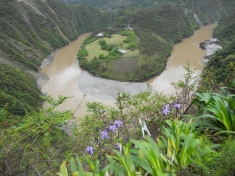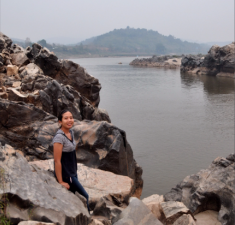It’s All About the Rivers: A Conversation with International Rivers’ Asia Teams
For this final issue of WRR, we turned to some of our regional staff in Asia to ask them about their important work. We spoke with Bharat Seth in India, Pianporn Deetes in Thailand, and our China team.
What river stirs your heart the most?
Bharat: My heart bleeds for the Yamuna. It is a river that flows through my city of birth. But it’s a sewage canal, and our city has no connect to the lifeline. The river is in need of a people’s movement, with government support. A clean up and plan to let the river flow must become a public spending priority. Then for sheer scale, there's the Ganga: roughly 500 million people dependent on it for irrigation, industry, drinking and other domestic needs.
China team: We would have to say China’s Southwest Rivers, which are the mother of most of Asia’s mighty rivers. That includes the Jinsha (Upper Yangtze), Lancang (Upper Mekong), Nu (Upper Salween), Dulong (Upper Irrawaddy), Yaluzangbu (Upper Brahmaputra). These are mostly transboundary rivers with high biodiversity values and rich in minority cultures. These rivers have been targeted for large-scale hydropower development with cascades as many as 20-30 dams. Among those rivers, the Nu is the only river that does not yet have big dams.
Pianporn: The Salween River (also known as the Nu in China) is also my choice; its wild and natural beauty still remains, along with very rich biodiversity. The people of the Salween River are strong and brave. While many are marginalized ethnic minorities, often with no citizenship in any country, they stand up and speak out for the river and their rights. They know the importance of the river to their livelihoods and they inspire me.
What are the biggest challenges your program is facing now?
Pianporn: For us in Southeast Asia, the natural resources provided by our rivers are very important. Most people still live in rural areas, and depend on natural resources for food, livelihoods, local economies and culture. While the dam industry may advertise hydropower projects as free or affordable sources of electricity, this is often not the case. The reality is that the cost for rural farmers and fisherman and their families would be significant, as their ecosystem services are taken away. This is a a huge challenge.
The Mekong region is growing very fast, and the hydropower industry and electricity monopolies tell us demand for electricity in the region will double or triple in the near future. This is why we see a lot of plans to build large-scale hydropower – for example, 11 dams on the Lower Mekong mainstream. Do we really need this much electricity for the region? Energy planning in the region has become a monopoly, with just a small handful of people deciding on the plans. There is limited space for civil society to participate in the process. One of our key messages to decision-makers is that we need comprehensive options assessments, following the recommendations of the World Commission on Dams, along with a democratic energy planning process. We need to identify the most sustainable energy options available, and to value ecosystems and rivers, rather than treat them as simply a source of electricity.
Take for example the Mong Ton Dam on the Salween River. Thailand’s Energy Authority (EGAT), China’s Three Gorges Corporation, and a Burmese company are all involved in the project, however they are still deciding where to sell the electricity, whether it will go to Thailand or China. What this means is that this project is not being built to satisfy the perceived demand for electricity in these countries, but rather to satisfy the construction companies for their own business interests. The Mong Ton Dam will affect the lives of some 300,000 people who have not been informed or consulted about the project. They fled area in central Shan State during the past two decades due to civil war, and are refugees. What will happen to them when they can no longer return to their homes because their villages have been drowned by a reservoir? This type of decision-making cannot be allowed to continue; companies, investors and governments must be held accountable.
China Team: A lack of baseline information about the environmental status of the rivers. In most cases, it does not exist and the dams are built without it. We work with experts who are willing to work with NGOs long term to document and protect these rivers. These experts build capacity building in local NGOs and International Rivers to understand the value, impacts and changes in China’s last remaining free-flowing rivers. In China, hydropower projects can be a sensitive topic and in the past environmental groups concern for healthy rivers has been conflated with opposition to the government. However, our purpose has always been to show governments around the world the value of healthy rivers and we don't have any hidden agendas.
Bharat: The incumbent government in India is pro-hydro and has also been pushing for a huge scheme to interlink the nation’s rivers. Another concern is that the judiciary has taken a favorable stance on interlinking of rivers as part of a public-interest litigation and has called for speedy implementation by forming a committee to expedite the process.
What do you hope the legacy of your team's work on the ground will be?
Bharat: Our vision is to protect the rights of communities by ensuring project proponents do not circumvent existing laws, nor do State and Central government seek to unlawfully expedite destructive dam projects. We also seek to promote environmentally sustainable policies and laws to improve the state of Indian rivers, all the while recognizing community rights over resources in order to prevent skewed distribution of wealth by ensuring projects protect the well being of affected communities. We have played a crucial role in building a strong, well-informed network of partner groups and movements on a national and regional scale that address the issues of rivers, dams, and climate change and effectively advocate for legislative and systemic changes.
China Team: We hope that decision makers in China can learn from past experience in dam building and avoid repeating mistakes. We hope China will no longer sacrifice the rivers to ill-managed hydropower development or malfunctioning public policy. We hope China can proactively draw ecological red lines, promote renewable energy, and push for river protection legislation. We especially hope Nu River can be saved.
Painporn: Over the past 20 years our team has contributed a lot in strengthening the movement in the region, providing technical support to partners and framing the debate around the impacts of hydropower projects. We have been able to see a change in Thailand since the Pak Mun Dam was built. International Rivers has been a part of the Pak Mun Dam movement for the past two decades. It was a case study for the World Commission on Dams and was clearly shown to be unviable. Pak Mun Dam has made it increasingly more difficult to build dams in Thailand as community resistance and public opposition has grown stronger.
What's the most important work you hope to accomplish this year?
China Team:The Nu is the last battle for Chinese NGOs to fight; the river should be preserved from damming because of its pristine nature and ecosystem values. We hope our work can ensure that future generations can also benefit from a healthy and thriving Nu River system.
Pianporn: Our role in the region is to continue to press for transparency and accountability from decision-makers, and to raise public awareness and create space for greater participation in decision-making around the development of hydropower projects. An important 2015 goal is for the Salween: we want the affected people to be able to participate more in the dam process, the decision-making made more accountable, and hopefully, further delays with the Salween Dams. We are also pressing for the cancellation of the Don Sahong Dam on the Mekong River. While we may be small with just a few people, our work in the region is important and our agenda is big.
Bharat: With the new government, space for dissent has been squeezed. The Ministry of Home Affairs has begun reviewing funding sources of environmental NGOs, many of whose accounts have been frozen this past quarter. In this setting it has become increasingly harder for non-state actors to engage with government; many of our partners are reluctant to even approach the government. We on the other hand are walking a tight rope in attempting to strengthen environmental governance by working with government officials in a non-adversarial and non-confrontational manner, all the while without diluting our stance on issues related to the impacts of hydropower on river health. We are also playing a key role in movement building in the Himalayan region by unifying activists, journalists, academics and others, and sharing news and analysis from the region.





